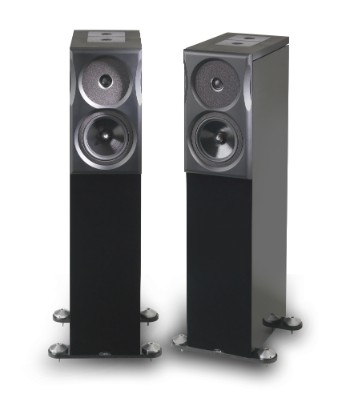The Ultimatum project was a labour of love for Bob Surgeoner. It began in 1995 as a no-compromise design intended to deliver the very best attributes of Neat’s accumulated ideas and expertise, and development took place over several years.
Originally conceived as a single model, the proptotype sported several design cues which can be identified in what eventually became the Ultimatum MF9 loudspeaker six years later. The slim, 150cm tall enclosure, with separate cavities to house each drive unit in an extended d’Appolito array. Employing 4 x 168mm main drive units in each cabinet, the driver configuration was designed to simulate a point source.
The Ultimatum MF9 was launched in 2001 to great critical acclaim and international commercial success. It was soon followed by smaller variants, the 120cm high MF7, the 100cm MF5, and the standmount/bookshelf MFS model. All of these versions adhered to those principles which rendered the Ultimatum models as being among the very best in the world.
The original line up was upgraded recently to ‘XL’ versions, further improving all aspects of their performance.
TECHNICAL DETAILS
The iso-baric theme reaches a new level with the Ultimatum range. After several years of development, we launched a no-compromise loudspeaker, the Ultimatum MF9, in 2000. It featured several key design principles which Neat believe to be of particular importance.
1) Iso-baric (compound) bass loading with bass-reflex tuning.
2) Birch Plywood cabinet construction. Plywood possesses the best sonic behaviour of all wood based enclosure materials.Neat prefer wood as it offers a well balanced combination of stiffness and self damping.
3) Discrete internal cavities for each drive unit in the system, each sealed from the others. This eliminates interference between the drive units operating within the enclosure, allowing each to do its job unhindered.
4) The use of Neat’s 6.5” (168mm) bass/midrange drive units. A treated paper cone with ferrite magnet. This type of main driver offers an ideal balance of the compromises required to deliver speed, bass depth and crossover cohesion.
5) The use of area-drive super-tweeters for the extension the upper frequencies. Those used in the Ultimatum series extend beyond 40K. It is astonishing how much this information affects the content within the ‘normal’ frequency range.
6) Optimal coupling of the drive unit baffle to the main enclosure. The system used in the Ultimatum is a high density fibreboard baffle, coupled to the main Birch Plywood enclosure by means of a polyethylene membrane. This makes a very inert platform for the drive unit/baffle/cabinet interface, thus allowing all of the drive units to deliver their performance with a minimum cabinet colourations.
The current Ultimatum ‘XL’ versions retain these principles but feature an improved main tweeter and revised crossover. The range comprises the standmount XLS, and the floorstanding XL6 and XL10 models.



